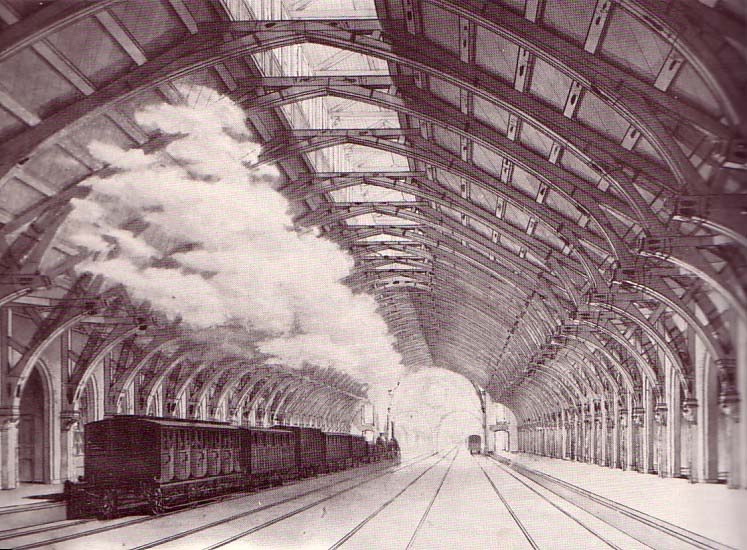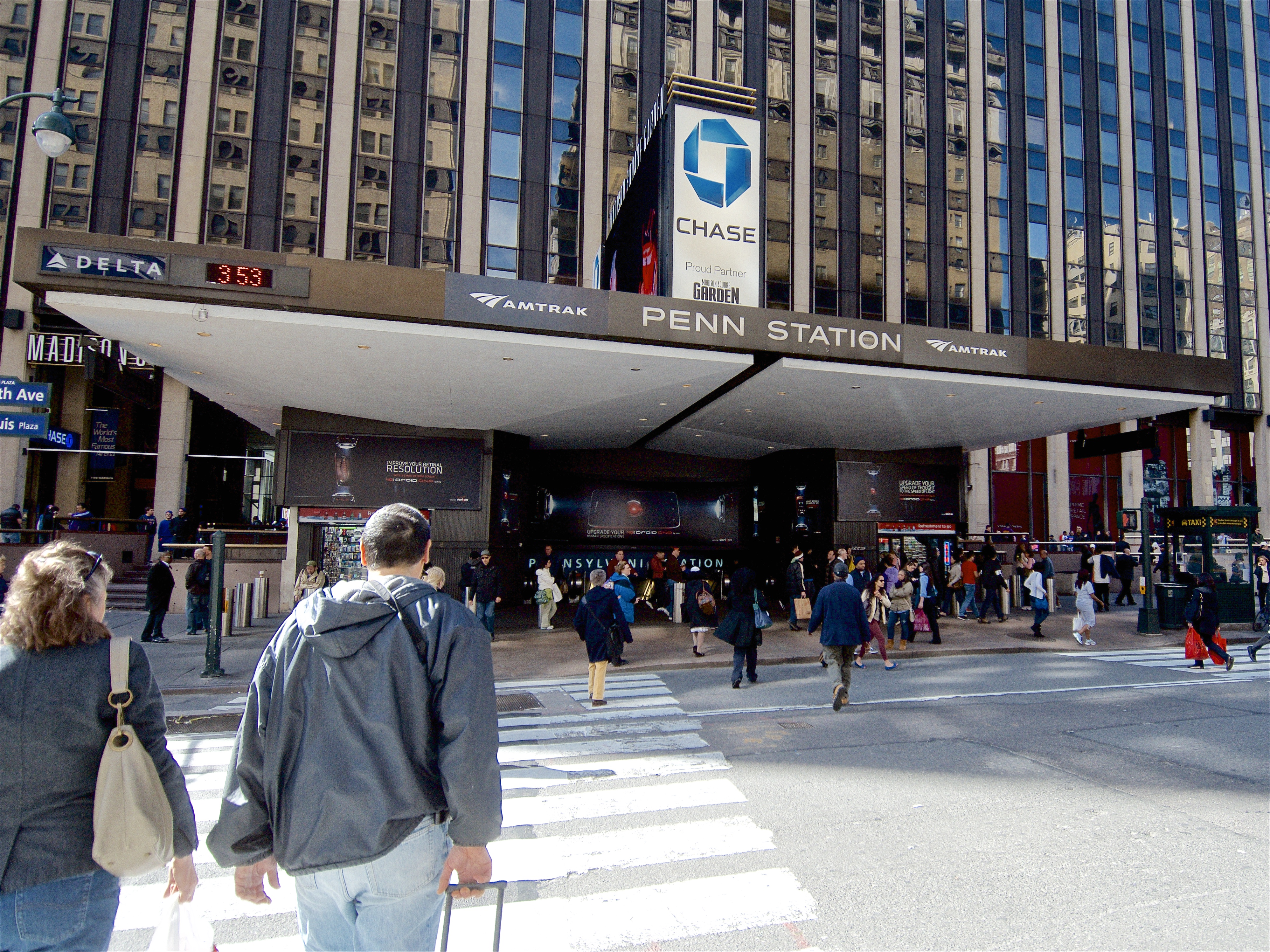|
Hamburg Central Station
Hamburg Hauptbahnhof (abbrev. ''Hamburg Hbf'') is the main railway station of the city of Hamburg, Germany. Opened in 1906 to replace four separate terminal stations, today Hamburg Hauptbahnhof is operated by DB Station&Service AG. With an average of 550,000 passengers a day, it is Germany's busiest railway station and the second-busiest in Europe after the Gare du Nord in Paris. It is classed by Deutsche Bahn as a category 1 railway station. The station is a through station with island platforms and is one of Germany's major transportation hubs, connecting long-distance Intercity Express routes to the city's U-Bahn and S-Bahn rapid transit networks. It is centrally located in Hamburg in the Hamburg-Mitte borough. The ''Wandelhalle'' shopping centre occupies the north side of the station building. History Before today's central station was opened, Hamburg had several smaller stations located around the city centre. The first railway line ( between Hamburg and Bergedorf) was ... [...More Info...] [...Related Items...] OR: [Wikipedia] [Google] [Baidu] |
Railway Station Types In Germany
The railways in Germany use several abbreviations to differentiate between various types of stations, stops, railway facilities and other places of rail service. Places with a set of points * – ' (railway station), defined as a place where trains may start, terminate, stop, overtake, meet or change directions, and that has at least one set of points. It can be additionally named after its purpose: ** – ', the main or central station of a town or city. Also the only abbreviation commonly found on station timetables and signs. ** – ' (passenger station), usually used to differentiate in places that have several types of stations, but only one passenger station. ** – ' ( long distance station) ** – ' (freight station) ** – ', a station only for operational tasks like train overtakes. ** – ' ( marshalling yard) ** – ' (transshipment station) ** – ', a station serving a power plant. ** – ' ( mail station) * – ' (part of a station), used when a station con ... [...More Info...] [...Related Items...] OR: [Wikipedia] [Google] [Baidu] |
Railway Station
Rail transport (also known as train transport) is a means of transport that transfers passengers and goods on wheeled vehicles running on rails, which are incorporated in tracks. In contrast to road transport, where the vehicles run on a prepared flat surface, rail vehicles (rolling stock) are directionally guided by the tracks on which they run. Tracks usually consist of steel rails, installed on sleepers (ties) set in ballast, on which the rolling stock, usually fitted with metal wheels, moves. Other variations are also possible, such as "slab track", in which the rails are fastened to a concrete foundation resting on a prepared subsurface. Rolling stock in a rail transport system generally encounters lower frictional resistance than rubber-tyred road vehicles, so passenger and freight cars (carriages and wagons) can be coupled into longer trains. The operation is carried out by a railway company, providing transport between train stations or freight customer facilit ... [...More Info...] [...Related Items...] OR: [Wikipedia] [Google] [Baidu] |
Deichtorhallen
The Deichtorhallen in Hamburg, Germany, is one of Europe's largest art centers for contemporary art and photography. The two historical buildings dating from 1911 to 1913 are iconic in style, with their open steel-and-glass structures. Their architecture creates a backdrop for spectacular major international exhibitions. In 2003 the southern hall was dedicated to the medium of photography, creating the House of Photography. Since 2011, the two buildings at the interface of Hamburg's Kunstmeile and Hafencity have been supplemented by a satellite in Hamburg's Harburg district, the Sammlung Falckenberg. History Between 1911 and 1914, the "''Deichtorhallen''" ("the levee gate halls") were built as market halls on the grounds of the former Berliner Bahnhof railway station, Hamburg's counterpart to Berlin's Hamburger Bahnhof. They constitute one of the few surviving examples of industrial architecture from the transitional period between Art Nouveau and 20th century styles. The two h ... [...More Info...] [...Related Items...] OR: [Wikipedia] [Google] [Baidu] |
Hamburg Berliner Bahnhof
The Berliner Bahnhof (Berlin line station) in the German city of Hamburg was the western terminus of the Berlin-Hamburg railway opened in 1846. It was previously the site of the station built in 1844 to a design by Alexis de Chateauneuf for the Hamburg-Bergedorf Railway. Berliner Bahnhof was completed in 1857 and closed in 1903. Structural features The former Bergedorfer Bahnhof was extended for the needs of the Berlin-Hamburg railway using red brick with plastered cornices and provided with a 148-meter-long and 23.5 m-high wooden train shed with four tracks. This train shed was considered at the time to be the most substantial wooden structure in Germany. The station building was divided into departure and arrival areas with a baggage check-in and check-out and waiting rooms of different classes. It also had a ladies room. The commissioning took place on 15 December 1846, but the renovation and construction of the 173 m-long building complex, the freight tracks and the ... [...More Info...] [...Related Items...] OR: [Wikipedia] [Google] [Baidu] |
Hamburg-Bergedorf Railway Company
The Hamburg-Bergedorf railway opened in 1842 is one of the oldest lines in Germany and was the first railway line in Northern Germany. The 16.5 km long line was extended to Berlin in 1846. It linked Bergedorf Station (German: ''Bergedorfer Bahnhof'') in Hamburg, near Deichtorplatz (just south of the modern Hamburg Hauptbahnhof) with the original Bergedorf station at Neuen Weg in Bergedorf. Hamburg public opinion was most interested in a rail connection with the Baltic port of Lübeck. This route would have, however, needed to pass through Holstein, which was administered in a personal union by the Danish king. Denmark’s consent was not required for a line from Hamburg to Bergedorf, since it would only run through areas controlled by Hamburg. The track was planned and surveyed by the English engineer William Lindley in 1838. The opening was scheduled for 7 May 1842. Two days earlier, the Great Fire of Hamburg broke out and largely destroyed the city. The first trips were ... [...More Info...] [...Related Items...] OR: [Wikipedia] [Google] [Baidu] |
Hamburg-Mitte
Hamburg-Mitte (Hamburg Central) is one of the seven boroughs of Hamburg, Germany, covering most of the city's urban center. The quarters of Hamburg-Altstadt and Neustadt cover much of the city's historic core. In 2020 the population was 301,231. History In 1937 several settlements (e.g. Finkenwerder), villages and rural areas were passed into Hamburg enforced by the Greater Hamburg Act. On 1 March 2008 due to a law of Hamburg, the quarter Wilhelmsburg was transferred from the borough Harburg. The neighborhood HafenCity was formed from parts of the quarters Klostertor, Altstadt and Rothenburgsort. The other part of Klostertor was transferred to Hammerbrook. From small parts of the borough Hamburg-Mitte (And Altona and Eimsbüttel) the neighborhood Sternschanze was created as a quarter in the borough Altona. Geography The borough severs Hamburg from the east to the west. In 2006, according to the statistical office of Hamburg and Schleswig-Holstein, Hamburg-Mitte has a to ... [...More Info...] [...Related Items...] OR: [Wikipedia] [Google] [Baidu] |
Intercity Express
The Intercity Express (commonly known as ICE ()) is a system of high-speed trains predominantly running in Germany. It also serves some destinations in Austria, Denmark (ceased in 2017 but planned to resume in 2022), France, Belgium, Switzerland and the Netherlands, mostly as part of cross border services. It is the highest service category of rail and the flagship train of the German state railway, Deutsche Bahn. There are currently 315 trainsets in use. ICE trains are the highest category (Class A) trains in the fare system of the Deutsche Bahn. Their fares are not calculated on a fixed per-kilometre table as with other trains, but instead have fixed prices for station-to-station connections, levied on the grounds that the ICE trains have a higher level of comfort. Travelling at speeds up to , they are tailored for business travellers or long-distance commuters and are marketed by Deutsche Bahn as an alternative to flights. Apart from domestic use, the trains can also be seen ... [...More Info...] [...Related Items...] OR: [Wikipedia] [Google] [Baidu] |
Transport Hub
A transport hub is a place where passengers and cargo are exchanged between vehicles and/or between transport modes. Public transport hubs include railway stations, rapid transit stations, bus stops, tram stops, airports and ferry slips. Freight hubs include classification yards, airports, seaports and truck terminals, or combinations of these. For private transport by car, the parking lot functions as a unimodal hub. History Historically, an interchange service in the scheduled passenger air transport industry involved a "through plane" flight operated by two or more airlines where a single aircraft was used with the individual airlines operating it with their own flight crews on their respective portions of a direct, no-change-of-plane multi-stop flight. In the U.S., a number of air carriers including Alaska Airlines, American Airlines, Braniff International Airways, Continental Airlines, Delta Air Lines, Eastern Airlines, Frontier Airlines (1950-1986), Hughes Airwest, ... [...More Info...] [...Related Items...] OR: [Wikipedia] [Google] [Baidu] |
Island Platforms
An island platform (also center platform, centre platform) is a station layout arrangement where a single platform is positioned between two tracks within a railway station, tram stop or transitway interchange. Island platforms are popular on twin-track routes due to pragmatic and cost reasons. They are also useful within larger stations where local and express services for the same direction of travel can be provided from opposite sides of the same platform thereby simplifying transfers between the two tracks. An alternative arrangement is to position side platforms on either side of the tracks. The historical use of island platforms depends greatly upon the location. In the United Kingdom the use of island platforms is relatively common when the railway line is in a cutting or raised on an embankment, as this makes it easier to provide access to the platform without walking across the tracks. Advantages and tradeoffs Island platforms are necessary for any station with many th ... [...More Info...] [...Related Items...] OR: [Wikipedia] [Google] [Baidu] |
German Railway Station Categories
The approximately 5,400 railway stations in Germany that are owned and operated by the Deutsche Bahn subsidiary DB Station&Service are divided into seven categories, denoting the service level available at the station. This categorisation influences the amount of money railway companies need to pay to DB Station&Service for using the facilities at the stations. Categories Category 1 The 21 stations in Category 1 are considered traffic hubs. They are permanently staffed and carry all sorts of railway-related facilities, as well as usually featuring a shopping mall in the station. Most of these stations are the central (commonly referred to as main) stations (''Hauptbahnhof'' or ''Hbf'') of large cities with 500,000 inhabitants and above, though some in smaller cities, such as Karlsruhe Hauptbahnhof, are regarded as important because they are at the junction of important railway lines. Berlin, Hamburg, Munich and Cologne, the four biggest cities in Germany, have more than ... [...More Info...] [...Related Items...] OR: [Wikipedia] [Google] [Baidu] |




